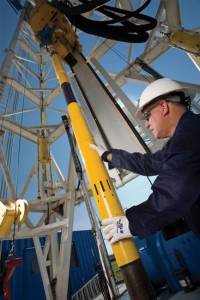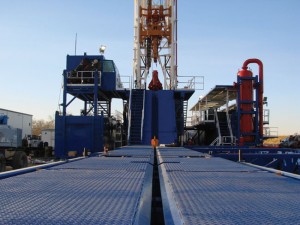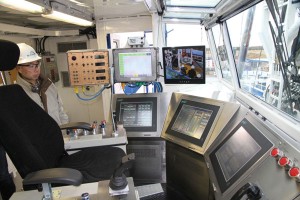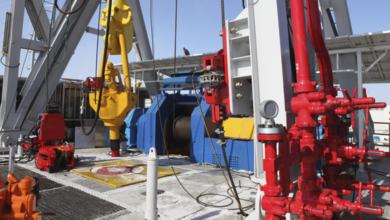Drilling & Completion Tech Digest

Baker Hughes performs first 40-stage open-hole completion in Williston Basin
A 40-stage open-hole completion has been successfully installed in the Williston Basin by Baker Hughes for Whiting Petroleum Corp, marking the most number of stages performed in a single lateral frac sleeve/packer completion system.The Baker Hughes FracPoint EX-C multistage fracturing system was deployed in the Smith 14 29XH horizontal well. It is a modular system that can be optimized according to customer specifications. In many areas of the Williston Basin, Baker Hughes’ REPackers custom-designed reactive element packers are used in the FracPoint EX-C system to isolate intervals of a horizontal section while frac sleeves are used for the precise delivery of the fracture treatment.Reactive element packers allow for a wide range of open-hole sizes and improve the capabilities of packer and sleeve completions. The multistage fracturing system extends current capabilities to 40 stages via 1/16-in. incremental changes in ball size to achieve an increased number of ball seats. The patented design provides additional mechanical support to the ball during pumping operations.The Bakken Shale/Three Forks play in North Dakota has experienced an increase in productivity due to fracturing improvements using multistage, open-hole packer and sleeve systems.“The industry continues to push the limits of total frac stages in horizontal completions in the Bakken Shale and other unconventional reservoirs… We are excited about the potential of FracPoint EX-C – the latest in our completion systems specifically designed for horizontal shale completions,” said Paul Butero, president of the US Land region for Baker Hughes.
FracPoint and REPackers are trademarks of Baker Hughes.
New water-based drilling fluid designed for HPHT shale wells
M-I SWACO has released the ENVIROTHERM NT water-base drilling fluid for high-pressure, high-temperature (HPHT) wells, including those in shale plays, environmentally sensitive areas or projects that experience high temperatures and require a water-base drilling fluid system. The system is stable in the presence of contamination from soluble calcium, salts and acid gases. It can be used at temperatures above 450°F and densities up to 19.0 lbm/gal and has been field proven under severe conditions over 350°F (177°C), exhibiting stable properties while drilling and during static conditions.
ENVIROTHERM is a mark of Schlumberger.
Precision Drilling rig drills record well on Manifa in Saudi Arabia
Using a Precision Drilling rig, a drilling team on the Manifa Field set a record for Saudi Aramco when it finished drilling the longest well in Saudi Arabia to a total depth of 32,136 ft and completed a horizontal power water injector across the Lower Ratawi reservoir. The team exceeded the drilling progress KPI by more than 32 ft/day and beat the lost-time KPI by nearly 3.5%. This same team set an earlier record while working on the 30,850-ft Manifa well.The team cited several reasons for success, including the use of high-torque drill pipe connections, optimized well trajectory, proactive involvement of support personnel and around-the-clock support, comprehensive preplanning and intensive communications.Discovered in 1957, the Manifa Field is in shallow waters southeast of Tanajib, about 200 km northwest of Dhahran. The development strategy of Manifa is based on optimum use of onshore drilling. Instead of developing Manifa completely from offshore platforms, it is developed from 27 drilling islands connected by a 47-km long causeway, in addition to 16 onshore drill sites and 13 platforms.Extended-reach wells, such as the two mentioned here, are required for optimum field coverage.
Shale-optimized bit targets faster penetration rates
Smith Bits has introduced its Spear shale-optimized steel body polycrystalline diamond compact (PDC) bit, designed for shale plays to efficiently drill a curve and a long lateral hole section for faster penetration rates in low hydraulic energy environments. The bit has been used in the Bakken, Barnett, Marcellus, Haynesville and Eagle Ford. In the Marcellus shale, for example, target ROP for drilling the horizontal leg was 50 ft/hr. The Spear bit achieved ROPs in excess of 65 ft/hr.
Spear is a mark of Schlumberger.

Saxon ATDs: taking a systems approach to efficient drilling
When Canada-based Saxon Energy Services began designing its Advanced Technology Single (ATS) rig back in early 2006, the thought was to create a drilling solution for shallow to medium depths. “We wanted a strong emphasis on making the loads smaller and introduce AC VFD technology and a smarter mud system. Really, at the end of the day, we wanted to make the cost per foot for the operator as low as possible,” said Kevin Jonah, Saxon manager of engineering.
But once the ATS rigs got out into the field, operators soon began stretching the rigs to their limits – drilling out to 12,000 ft to 13,000 ft. Within about a year, the company began designing the Advanced Technology Double (ATD), a higher-capacity rig that still kept “a lot of the fundamental core values of the ATS intact,” Mr Jonah said.
ATD features
Because the ATD is targeted for drilling in shallow- to medium-depth environments, Saxon believes that one of the most important features had to be high mobility. “In shallow environments, you need to drill a lot of wells – hundreds, maybe – to make these reservoirs financially viable,” said Mark Helmer, Saxon senior VP & chief business development officer. “When you’re drilling that number of wells, you have to look at every aspect of the well. With our ATS and ATD rigs, we basically looked at saving minutes. Because if you save a couple of minutes on a rig move and you drill 300 wells, that’s already a number of wells that you’ve saved.”
The ATD can be rigged up without the use of cranes and features integrated compact loads that not only comply with Australia’s roading regulations but also are suitable for tight-road areas such as Europe or the Marcellus in Pennsylvania. Further, a skidding package can be installed on the ATD at any time – also without the use of cranes. “We basically took every traditional load and shrunk the width, the length, the height and even made it lighter. And we have the ability to remove the mast from some of the critical loads so the requirement for cranes is no longer there,” Mr Jonah explained.

Saxon believes that, because of the time saved on rig moves, its ATDs can compete with triple rigs on a release-to-release basis. “Because, after all, what counts is not the individual parts of the well but the total time on the well,” Mr Helmer said. “It’s a systems approach.”
To improve the safety of pipe handling on the ATD, Saxon uses a proprietary dual makeup power catwalk that can handle a tubular length of no greater than 62 ft, compared with 45 ft on a more conventional power catwalk. “We have the ability to make up a double stand in a horizontal fashion and deliver that to the wellbore with mechanical devices. Literally nobody has to touch the pipe during that process,” Mr Jonah said.
Other features of the ATD include its noise-attenuated loads (reduced noise to the 80-decibel range) and compliant emissions control. Mr Jonah added that Saxon is looking to take its rigs from being just highly mechanized to having automated drilling capabilities. “The next step is how do you make each function act without any human involvement… Instead of doing 15 individual tasks, you press one button and it goes through 15 sequences,” Mr Jonah said.
The ATD is currently available in either the 400,000-lb hookload version (ATD 400) or the 500,000-lb hookload version (ATD 500). Work is being done on a 750,000-lb hookload version, and to scale up even further, Saxon has started work on the Advanced Technology Triple (ATT) rig. Saxon estimates that it would take approximately 12 months to deliver an ATT or approximately eight months to deliver an ATD once an order has been made.



